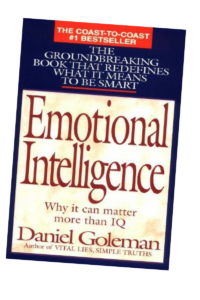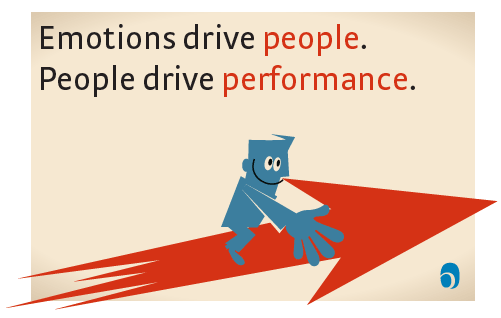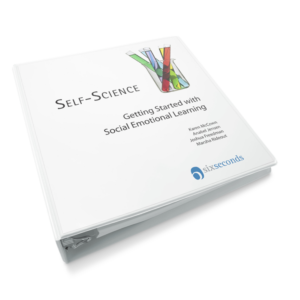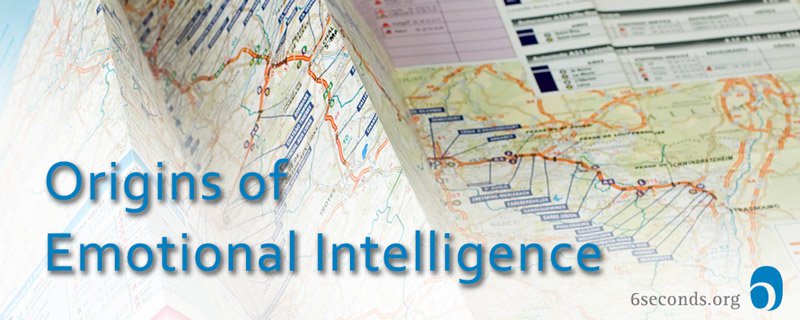Since the 1995 publication of Daniel Goleman’s international bestseller Emotional Intelligence, Why It Can Matter More Than IQ, a global movement has developed to bring “EQ” into practice in businesses, schools, and communities around the globe. How did it start, what does it mean – and where is it going?
From American Express to Avon, businesses have begun to embrace the concept. Jack Welch was even discussing EQ [1] and the Harvard Business Review calls it “the key to professional success.”[2] Schools, hospitals, and government agencies world-wide are adopting EQ practices. From elementary school students to army officers, a curriculum of emotional awareness is providing a new perspective on people.
According to Dr. Goleman, it all began with two psychology professors on a summer’s day:
“John Mayer and Peter Salovey invented the whole field,” Goleman explains, “when they were chatting about politics while painting a house.” Salovey (now President of Yale University) and Mayer (now Professor at University of New Hampshire) were talking about their research on cognition and emotion, and got to discussing a politician. They wondered: How could someone so smart act so dumb? Their conclusion:
Smart decision-making requires more than the intellect as measured by traditional IQ.
The story of emotional intelligence begins with two professors chatting about politics while painting a house and wondering… how could that smart person act so dumb?
Goleman continues the story, “And because of that conversation, they published a wonderful seminal article — but in an obscure journal. The moment I saw their concept of emotional intelligence all kinds of bells went off. And I thought, ‘I have to write about this!'” With over 5 million copies in print in 30 languages, Goleman was right: The world was ready to learn about this powerful concept.
Goleman, Salovey, and other leaders in the field met to share best practices and current research at the annual NexusEQ Conferences, starting in San Francisco in 2000, and continuing around the globe — including Holland 2005, and 2013 NexusEQ Conference at Harvard University had participants from 32 countries.
“This is a worldwide movement, but people are isolated,” Goleman explains. “To everyone who is laboring in solitary circumstances — in a school, in a business, in a hospital, a university, where ever you may be: You are part of a community — a virtual community of like minded people pursuing this important work. The chance to come together and meet others in your ‘family’ is enormously important.”
What makes emotional intelligence so appealing? Partly because it answers a widespread longing to understand the complexities of human interaction. Partly because it allows practitioners to bring compassion, empathy, and wisdom to schools and organizations. And partly because emotional intelligence delivers impressive bottom-line results.
According to Goleman, one key benefit is that “emotional intelligence can help people make better decisions.” This increased effectiveness is invaluable for business, essential for education, and transformational for personal life.
“emotional intelligence can help people make better decisions” – Daniel Goleman
The Business of EQ
What do American Express, Avon, Qatar Airways, Unilever, HSBC, Pfizer, Lockheed, Hilton, Emaar, Motorola, and Johnson & Johnson have in common? At various levels, all are turning to emotional intelligence to improve organizational performance. Here is an entire database of business cases and other case studies showing how emotional intelligence is linked to bottom-line performance and critical outcomes. In my book, at the Heart of Leadership, I summarize the decades of research into one 6 words:
Emotions drive people. People drive performance.

To understand how organizations are increasing value with EQ, The Business Case for Emotional Intelligence lays out the data and best practices. As explained in Six Seconds’ EQBiz, key areas are leadership development, sales, talent management (selection, development, retention, strategy), change, culture and other people-centered processes.
“EQ defines our capacity for relationship,” Goleman says, adding this is essential for leaders whose choices are echoed through dozens and hundreds of relationships in a complex web. Leaders who uses their emotional efficacy to inspire confidence, commitment, and caring will get better results. “Every level of organization is an emergent property of the one beneath it. You can look at two people interacting and then see how that cascades into teams, groups, and whole organizations.”
“In Primal Leadership, my colleague Annie McKee describes a wonderful woman working for UNESCO in South Asia,” Goleman elaborates. “She was a remarkable leader. Her mandate was the health of half a billion women and children. She used her emotional intelligence to inspire her entire staff about the mission. Because they really cared, it wasn’t just a job, she helped her team become far more effective.”
This ability to bring out the best in people translates to bottom-line performance. At L’Oreal, sales agents selected on the basis of certain emotional competencies added an annual net revenue increase of $2,558,360. [3] The US Air Force saved $2.7 million in recruiting costs by using an EQ profile. [4] A year-long EQ initiative at the Sheraton Studio City in Orlando helped improve guest satisfaction, reduce turnover, and boost market share by 24%. [5] More data is available from the Consortium for Research on Emotional Intelligence in Organization (www.eiconsortium.org) and Six Seconds’ free e-book, The Business Case for Emotional Intelligence.
Bringing EQ to School
One of the most exciting areas of EQ practice is in education. From Durban, South Africa, to Jakarta, Indonesia — and nearly every city in between — educators are tapping the science of emotional intelligence to meet the promise of education’s mission. To learn why and how EQ works in education and key methods, explore this introduction to SEL.

For a review of current research, see A Case for Emotional Intelligence in Our Schools, which reviews how EQ improves achievement, wellbeing, and the school climate. As the school case explains, emotional intelligence comes to school at many levels. One is the way increased EQ helps teachers and administrators be more effective. For example, Six Seconds’ President Dr. Anabel Jensen worked for three years with one of the largest school districts in the US; the focus was on building a more effective workforce to the 12,000 employees.
Goleman says emotionally intelligent school leaders are more successful: “The seminal study was done for the Ministry of Education in the UK, where they looked at Heads of Schools. They found that in schools where the Head Teacher used a more emotionally intelligent leadership style, the higher the academic achievement of the students.” Why? “School leaders who use their EQ inspire teachers to be more dedicated and motivated so that they teach better — and therefore the students learn better.”
So the same logic that drives companies to boost EQ applies to schools; plus, schools see significant benefits for students. At a systemic level, an improved environment, or learning climate, facilitates increased achievement. At the individual level, when students increase their ability to manage the complexities of daily life they perform better. So many schools have introduced EQ, or social-emotional learning, as a basic skill within the curriculum. T he Collaborative for the Advancement of Social Emotional Learning (www.CASEL.org) has collected an extensive database of research on the subject. The conclusion: EQ training improves students’ relationships to school — which in turn improves their academic performance. The research shows students who learn effective social and emotional skills also have less risk of violence, pregnancy, or suicide.
he Collaborative for the Advancement of Social Emotional Learning (www.CASEL.org) has collected an extensive database of research on the subject. The conclusion: EQ training improves students’ relationships to school — which in turn improves their academic performance. The research shows students who learn effective social and emotional skills also have less risk of violence, pregnancy, or suicide.
In a pilot study of one of the pioneering approaches to emotional intelligence education, Self-Science, 100% of the teachers reported that the methodology increases cooperation and improves classroom relationships. They agreed (92%) that Self-Science helped increase student focus/attention and improve teacher/student relationships.
What if every child received evidence-based social emotional learning to grow emotional intelligence? It’s time!
EQ and Life
To capture the benefits of EQ for individuals, Goleman turns to the work of Nobel prizewinning economist, Daniel Kahneman, and the “Hedonic Treadmill.”
“It turns out that having more wealth does not increase your happiness” explains Goleman. “Going from starving poverty to just having enough is the biggest bump in happiness from increased affluence. And that means that you don’t need that lavish a standard of living to be happy. And happiness itself lets you get off the treadmill of ever-rising expectations. In EQ, one of the qualities that can be cultivated in the emotional self-management domain is how to manage your emotions and become more happy.”
While happiness may seem banal to some, happy people are healthier, more compassionate, and more successful. The implications are significant — what happens when people are more satisfied with life? It brings Goleman to the next stage of his research: “I am looking at the question of how can we all live best together, at every level — couples, families, communities, organizations and nations. How can we live together more sanely and compassionately?”
Like most of the people involved in emotional intelligence, Goleman finds benefits of this practice for himself. “I’ve been working on being more mindful and more empathic,” Goleman says he is inspired by his wife, Tara Goleman (author of Emotional Alchemy). “It is a spiritual book as well as a synthesis of mindfulness and cognitive therapy and Buddhist psychology. It shows the importance of reflective insight and compassion in living well — a message echoed by the Dali Lama. These values go hand-in-hand with my own thinking, and give me hope for my life too.”
The blend of spiritual awareness, mindfulness, and emotional intelligence enhances the quality of life — not through trappings, but by adding spice to the small moments of every day. “One of the qualities of this kind of awareness is that you are less bored and less anxious throughout the day. And more involved in what is going on, what ever you are doing.”
Goleman is quick to add, “I don’t see myself as particularly gifted in this domain. I am a psychologist, a researcher and a writer, but I am not a guru of emotional intelligence,” he qualifies. “I am a commentator — not the ‘Tiger Woods of Emotional Intelligence.’ The Dali Lama deserves the title!”
From Goleman, With Gratitude
There are countless examples of emotional intelligence coming into practice around the world. From prisons to military organizations, from classrooms to board rooms, this blend of cutting-edge science and common sense is getting attention.
Goleman credits the researchers and these innovators. “All I did was amplify someone else’s idea, and other people have run with it. The movement is a marvelous collaborative accomplishment. So I feel a lot of gratitude to people for that.”
Goleman points out that emotional intelligence is a global phenomenon: “This is not an American movement; this is the World’s movement.” Today, many leading EQ efforts are taking place around the globe. The growth of Six Seconds’ global network is just one example.
What’s next for the EQ? “For people who are passionate about EQ,” concludes Goleman,
“my wish is that we care more about what is going on in the world at large and use EQ to address the problems in front of us.” – Daniel Goleman
“Whether it’s local problems, national problems, Tsunami victims, or the horrible toll of poverty among children in the world,” he continues, “I hope emotional intelligence helps people shift away from personal gain and self interest — and instead they notice, care, and take action to do something about what needs to be fixed in the world. And I hope they use their best EQ in addressing these challenges.”
We face significant challenges in the world – to solve them, we’ll need to work together effectively. The key to doing so: Emotional Intelligence
♥
[1] Jack Welch, “Four E’s (a Jolly Good Fellow)” Wall Street Journal, January 23, 2004
[2] Harvard Business Review, Breakthrough Ideas for Tomorrow’s Business Agenda April 2003
[3] Spencer & Spencer, 1993; Spencer, McClelland, & Kelner, 1997 (cited in Cherniss, 2003
[4] Richard Handley, 1999, Conference Proceedings, NexusEQ 2003
[5] Joshua Freedman, Case Study: Emotional Intelligence at the Sheraton Studio City Hotel, Six Seconds, 2003
Interview by Joshua Freedman and Kees Blase, Jan 6, 2005; first published by Joshua Freedman Feb 1, 2005. Minor edits: July 12, 2015, Feb 29, 2024
- Coaching Through the Emotional Recession: Three Practical Tips for Trauma-Informed Coaching - May 1, 2024
- Knowing Isn’t Coaching: Three Emotional Intelligence Tools for Professional Coaches - April 3, 2024
- Coaching Down the Escalator: 3 Emotional Intelligence Tips forCoaches to Reduce Volatility & De-escalate Conflict in a Polarized World - March 6, 2024


Hi sir!
I just want to ask one thing here, if at workplace someone is not doing anything and you are doing. But when its the time to highlight your work that person is taking the credit like he/ she is doing. At that time I tried my best to control myself but sometimes I got emotional. Due to which the situation becomes more worse. So guide me what should I have to do at that time?
“Emotion is like a magnet transferred from one party to another
Emotional intelligence goes beyond academic knowledge and intelligence.
Emotional intelligence helps students to perform better at school and later in life because they will make effective decision makers.
Emotional intelligence results in individuals being much happier with life.
It is difficult to see how we can find happiness if we don’t have emotions, remove them and what is left, continuing species without joy is a recipe for extinction.
It is interesting work on the development of emotional intelligence. How can I measure it?
Emotional intelligence goes beyond academic knowledge and intelligence.
Emotional intelligence helps students to perform better at school and later in life because they will make effective decision makers.
Emotional intelligence results in individuals being much happier with life.
It is amazing how the concept of EI has evolved in all aspects of business, education and even personal life. I am still trying to assess how to assess EI.
Every school in every city in every country should have ‘Emotional Intelligence’ in their curriculum. This world would definitely be a better place if every person stopped to think about what it is they’re feeling and to control their reaction/response sensibly.
Extremely excellent tool to know about
You need to understand your own before you can understand others .
Oh my goodness – we how we need EQ! I totally identify with Joshua Freedman metaphor about the river & the state of flowing being the healthy state. I’m told I’m full of empathy – its all very well to have a big heart & feel concern for the stress laden environment & people around but you need to learn the skill of handling your own emotions first before you can help others. Why is it that we just don’t practice it enough? The ‘Chimp Paradox’ book was a very helpful insight – we have to understand & train that part of our brain & how it can overide any sort of logic once out of its cage & its hardwork!
Is there a danger of becoming less intuitive? Too examined and restrained when sometimes an “emotional” response is the most honest?
Hi Lynn – at Six Seconds, we focus on balancing various aspects of EQ. For example, we don’t think someone can be “too empathic” but if someone has a lot of empathy and not enough skill at handling emotions, then that out-of-balance would be likely to lead to challenges. Sometimes I use this metaphor:
When there’s too little water in the river, it stagnates and is destructive.
When there is too much water in the river, it floods and is destructive.
The healthy state is flowing.
Does that help?
Is it possible to get these articles in pdf? I prefer to read hard copy so I can make notes.
Hi Geoff, we do not have the article in PDF format. If you open the article and click File > Print, there’s usually an option to Save as PDF. I totally understand the desire to take notes!
Would really like to find you more about how this is achieved in the classroom.
Hi Sarah – we have a fantastic training on this called “EQ Educator” — see https://staging.6seconds.org/certification — and here’s an article: https://staging.6seconds.org/2014/05/24/self-science-emotional-intelligence-education/
emotional intelligent very close with humanity.if you understand others emotions you will be more understandable world.
Very interesting, I’m just taking it in .
Being open and awear.
Of course emotional intelligence when it is positively applied it really makes a great continuous improvement in business hence triggers high performance, high productivity, maximization of profit and outwit your rivals be at a competitive advantage.
Hello,
As you mention that EQ can be practically applied to school curricula, would you please share one or two of the best instructional interventions for the development of EQ in the elementary grades for use in the U.S.? Thanks
Hi Lisa – I think “the best” intervention is organic, growing in alignment with the culture of the school and the context. At Synapse School, which Six Seconds started, they do a good job of this – there’s no “program” and nothing packaged, but they use the tools and methods pretty consistently with everyone involved.
There’s more about Six Seconds’ approach to SEL here: https://staging.6seconds.org/education — including “Benchmarks” for implementation
Emotions drive people and people drive performance. My appreciation for the power of how emotions are at the helm of organisational direction is growing. It does make sense that to harness the power of EI one has to develop their own understanding and grow some of the fundamentals.
Very clearly said! One of our other “favorite phrases” that relates: Change starts from the inside.
that is so true, change starts with the individual, like the saying goes clean your windows to see the washing differently.
In the work place I find a real challenge in identifying emotions in others ,so while I can identify my own emotions -reading someone else’s to take account of them is a real challenge .
I was interested in the idea that passion can be unhelpful ,as I find that my enthusiasm and passion for service delivery can reduce any logic as my responses are more emotional
Hi Julie – in many workplaces it’s “strange” to talk about feelings, but it’s one of the best ways to start dealing with them effectively. Sometimes it’s easier to start with talking about emotions without talking about emotions 🙂 for example, “How are people doing with this idea?” “What are some of the ways people are responding to this?” “How ready are we for this?” — of course, when we can speak plainly and clearly it’s easier — and a lot more precise.
Wow, I could easily identify with this. I too face the same issue. I know many a times what is right, but find myself unable on how to effectively communicate it.
There is a new era and a new revolution of making the world a better place; this is the era of emotional intelligence. We are thankful to the pioneers and grateful to all who deem it prudent to research and help humanity with this new knowledge.
What famous professor said: “Emotion is like a magnet transferred from one party to another?